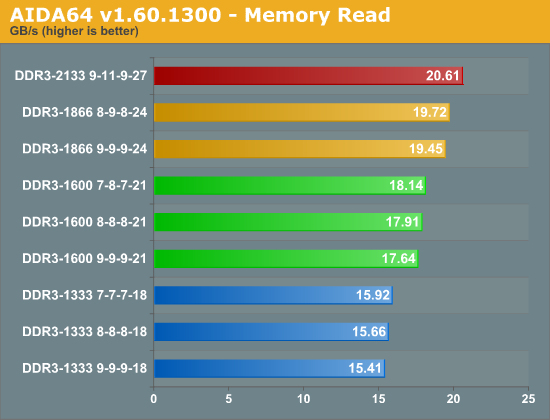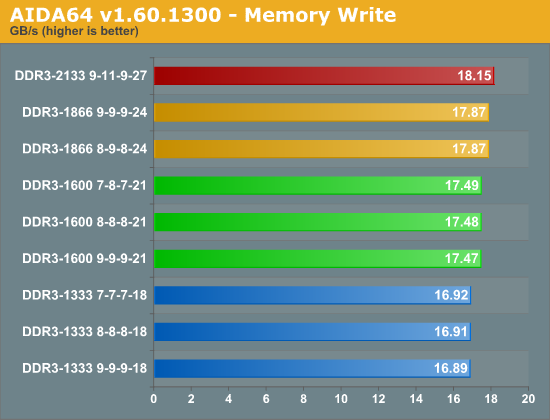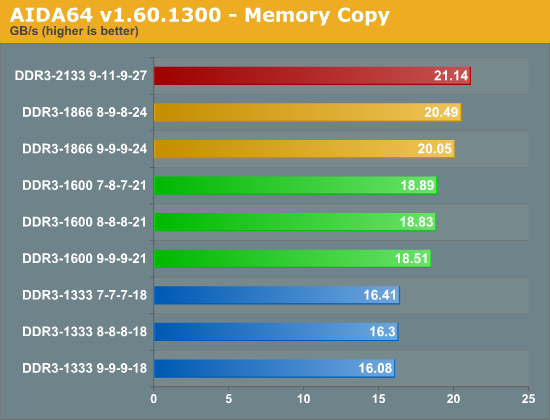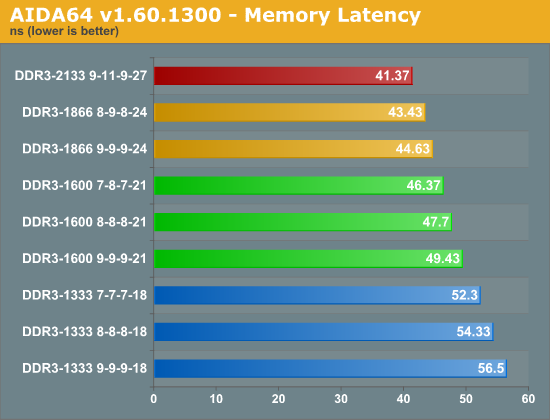Sandy Bridge Memory Scaling: Choosing the Best DDR3
by Jared Bell on July 25, 2011 1:55 AM ESTAIDA64 Memory Benchmark
AIDA64 provides a basic synthetic benchmark for comparing the read, write, and copy performance of system memory while also measuring latency. This should provide us the raw bandwidth for each memory configuration that was tested. Later on, we'll see how this translates into real world performance.




Our preliminary results show us the expected memory scaling. The faster DDR3-2133 memory has a ~36% advantage over the slowest DDR3-1333 memory in the read test, and the copy and latency tests show similar results. However, the write test closes the gap with only a ~7% difference between the fastest and the slowest. Overall, we see a linear performance increase as the memory clock speed is raised as well as when the CAS latency is lowered. Synthetic tests are really the best-case scenario, so let's move on to find out how the extra raw bandwidth affects our other tests.










76 Comments
View All Comments
Rick83 - Monday, July 25, 2011 - link
Do they take into account, that we should be using 1.5V DIMMs for Sandy Bridge?The addition of that requirement usually limits choice quite a bit.
compudaze - Monday, July 25, 2011 - link
The SNB datasheet does suggest that the max memory voltage is 1.575V, however, many motherboard and memory manufactures state that they haven't had any problems with memory running at 1.65V on SNB.compudaze - Monday, July 25, 2011 - link
Also, if you stick to the spec sheet, you shouldn't be running faster than DDR3-1333 memory.Taft12 - Monday, July 25, 2011 - link
You should be using 1.5V DIMMs anyway - if a memory OEM needs 1.65V to achieve the same speed and timings another vendor does at 1.5V, it's inferior memory.jdogi - Monday, July 25, 2011 - link
Just as your daily driver vehicle is likely inferior to a Mercedes or Ferrari. You should get a new car. You should not make any attempt to balance cost with the value. Just get the best. It's the only way to go. What's best for Taft is best for all.;-)
Iketh - Tuesday, July 26, 2011 - link
you didn't understand the logicMrSpadge - Wednesday, July 27, 2011 - link
I'm sure he did. What Taft failed to mention was that "at the same price, you should be using the memory spec'ed for less voltage". However, if some memory needs a little more voltage, but is way cheaper - balance cost and value.MrS
Rick83 - Wednesday, July 27, 2011 - link
Actually, the higher voltage is out of spec for the CPU memory controller and may wel impact longevity.So it's like buying the Ferrari, and running it on Biofuel with too much Ethanol that eats right through the tubing, but is marginally cheaper.
jfelano - Tuesday, July 26, 2011 - link
Not inferior, just older. All 1600mhz memory was 1.65v when it debuted. Then they came out with 1.5v, now even 1.35v.cervantesmx - Thursday, July 28, 2011 - link
That is correct indeed. Just purchased 8GB at 1600mhz running on 1.25v. $59.99. Free shipping.